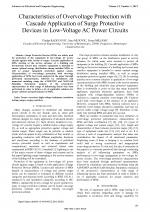| 3/2015 - 22 |
Characteristics of Overvoltage Protection with Cascade Application of Surge Protective Devices in Low-Voltage AC Power CircuitsRADULOVIC, V. |
| Extra paper information in |
| Click to see author's profile in |
| Download PDF |
Author keywords
arresters, high-voltage techniques, insulation testing, surges, surge protection
References keywords
power(18), voltage(16), surge(11), protection(9), standard(7), delivery(6), systems(5), protective(5), devices(5), part(4)
Blue keywords are present in both the references section and the paper title.
About this article
Date of Publication: 2015-08-31
Volume 15, Issue 3, Year 2015, On page(s): 153 - 160
ISSN: 1582-7445, e-ISSN: 1844-7600
Digital Object Identifier: 10.4316/AECE.2015.03022
Web of Science Accession Number: 000360171500022
SCOPUS ID: 84940747330
Abstract
Surge Protective Devices (SPDs) are widely used for protection of the equipment in low-voltage AC power circuits against wide variety of surges. Cascade application of SPDs starting at the service entrance of a building and downstream toward near sensitive equipment is intended to ensure optimal energy distribution among installed SPDs, as well as proper equipment protection against surges. Characteristics of overvoltage protection with two-stage application of SPDs have been analyzed in the paper through performed measurements, followed by simulations and numerical modeling using the ATP/EMTP and MATLAB Simulink. Parametric analysis of the protection's characteristics in wide range of influencing factors has been performed in order to define a set of applicable solutions for proper selection and performance of SPDs. |
| References | | | Cited By |
Web of Science® Times Cited: 7 [View]
View record in Web of Science® [View]
View Related Records® [View]
Updated 2 weeks, 6 days ago
SCOPUS® Times Cited: 11
View record in SCOPUS® [Free preview]
View citations in SCOPUS® [Free preview]
[1] Coordination of surge protective devices in low voltage AC power installations, Radulović, Vladan, Mujović, Saša, SN Applied Sciences, ISSN 2523-3963, Issue 1, Volume 1, 2019.
Digital Object Identifier: 10.1007/s42452-018-0003-1 [CrossRef]
[2] Analysis on design method of signal system surge protection devices, Li, Xiangchao, Cai, Lujin, Xu, Xiaopei, International Journal of Applied Electromagnetics and Mechanics, ISSN 1383-5416, Issue 4, Volume 56, 2018.
Digital Object Identifier: 10.3233/JAE-170069 [CrossRef]
[3] Effects of Built-In Varistors With Low Protection Voltages on Surge Protection Performances in Low-Voltage AC Power Systems, Radulovic, Vladan M., Miljanic, Zoran V., IEEE Transactions on Electromagnetic Compatibility, ISSN 0018-9375, Issue 3, Volume 62, 2020.
Digital Object Identifier: 10.1109/TEMC.2019.2914372 [CrossRef]
[4] An Improved Structure of an Adaptive Excitation Control System Operating under Short-Circuit, FILIP, I., PROSTEAN, O., VASAR, C., SZEIDERT, I., Advances in Electrical and Computer Engineering, ISSN 1582-7445, Issue 2, Volume 16, 2016.
Digital Object Identifier: 10.4316/AECE.2016.02006 [CrossRef] [Full text]
[5] A Review of AI-Driven Techniques for Power System Insulation Coordination and Surge Protection, Teodoro, Mark Anthony G., Benitez, Ian B., 2024 International Conference on IT Innovation and Knowledge Discovery (ITIKD), ISBN 979-8-3503-5546-8, 2025.
Digital Object Identifier: 10.1109/ITIKD63574.2025.11005282 [CrossRef]
Disclaimer: All information displayed above was retrieved by using remote connections to respective databases. For the best user experience, we update all data by using background processes, and use caches in order to reduce the load on the servers we retrieve the information from. As we have no control on the availability of the database servers and sometimes the Internet connectivity may be affected, we do not guarantee the information is correct or complete. For the most accurate data, please always consult the database sites directly. Some external links require authentication or an institutional subscription.
Web of Science® is a registered trademark of Clarivate Analytics, Scopus® is a registered trademark of Elsevier B.V., other product names, company names, brand names, trademarks and logos are the property of their respective owners.
Faculty of Electrical Engineering and Computer Science
Stefan cel Mare University of Suceava, Romania
All rights reserved: Advances in Electrical and Computer Engineering is a registered trademark of the Stefan cel Mare University of Suceava. No part of this publication may be reproduced, stored in a retrieval system, photocopied, recorded or archived, without the written permission from the Editor. When authors submit their papers for publication, they agree that the copyright for their article be transferred to the Faculty of Electrical Engineering and Computer Science, Stefan cel Mare University of Suceava, Romania, if and only if the articles are accepted for publication. The copyright covers the exclusive rights to reproduce and distribute the article, including reprints and translations.
Permission for other use: The copyright owner's consent does not extend to copying for general distribution, for promotion, for creating new works, or for resale. Specific written permission must be obtained from the Editor for such copying. Direct linking to files hosted on this website is strictly prohibited.
Disclaimer: Whilst every effort is made by the publishers and editorial board to see that no inaccurate or misleading data, opinions or statements appear in this journal, they wish to make it clear that all information and opinions formulated in the articles, as well as linguistic accuracy, are the sole responsibility of the author.



